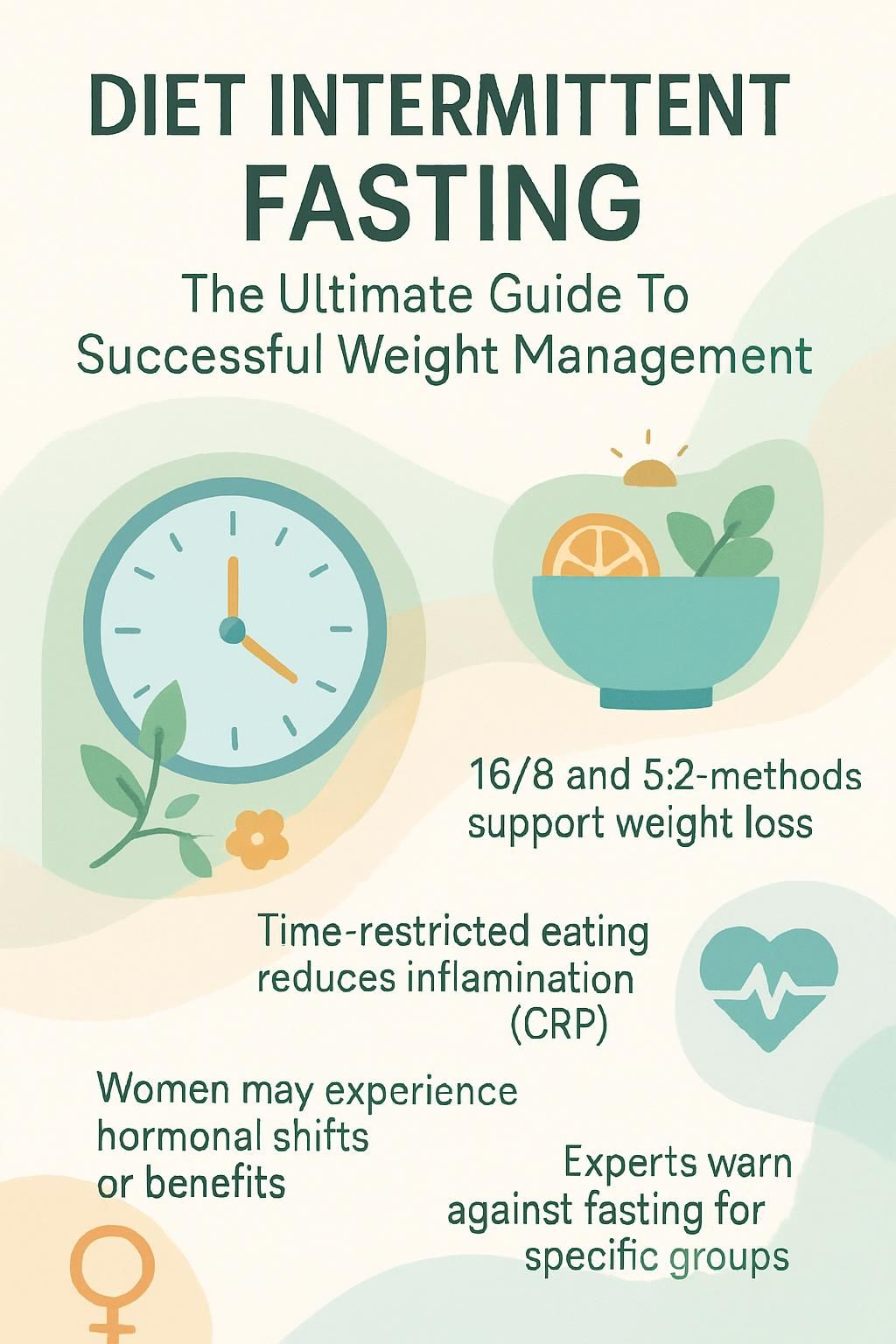Diet Intermittent Fasting: The Ultimate Guide To Successful Weight Management
Our Nutrition Assistant AI Suite will transform your body. You will lose fat, get toned, and build muscle. Gain confidence and optimal health.
You might find strict diets hard to follow or tough to sustain. Intermittent fasting is an eating pattern that cycles between periods of eating and fasting on a regular schedule. This guide gives you clear steps, facts, and practical tips for weight management with intermittent fasting. Small, steady changes can lead to big wins.
Key Takeaways
- Intermittent fasting methods like 16/8 and 5:2 can reduce body weight by up to 13 percent in studies from 2018 to 2022.
- Time-restricted eating may improve insulin sensitivity, lower inflammation markers like CRP, and support cell repair through autophagy.
- Women should track menstrual cycles, since long fasting windows can disrupt hormones. Those with PCOS may see benefits with careful calorie planning.
- Do not use fasting if you have type 1 diabetes, an eating disorder, or if you are pregnant or breastfeeding due to safety risks.
- For best results, choose nutrient-dense foods such as leafy greens, lean proteins, whole grains, and healthy fats. Speak with a healthcare provider before you start.

What Is Intermittent Fasting?

Intermittent fasting is a pattern of eating and fasting. It focuses on meal timing, not only on food choices. Research links it to weight loss, a steadier metabolism, and better blood sugar control.
What does intermittent fasting mean?
Intermittent fasting means you rotate between eating windows and fasting windows on a set schedule. It is about when you eat, not just what you eat.
A common plan is to fast for 16 hours, then eat within an 8-hour window. During the fast, you can drink water, plain tea, or black coffee because they have almost no calories.
Many people find this easier than counting every calorie. Skipping breakfast and eating from noon to 8 p.m. helped me cut late-night snacking and reduce overall intake.
Over time, this timing lowers daily calories and supports weight management without strict food rules.
“Fasting is not about starving, it is about timing your meals to help your body.”
How is intermittent fasting different from traditional diets?
Traditional diets focus on what to eat and often limit specific foods or calories. Intermittent fasting centers on when you eat. You can enjoy a wide variety of foods during eating windows if they fit your schedule and health goals.
Studies from 2018 to 2022 show intermittent fasting can match, and sometimes beat, standard calorie restriction for fat loss and insulin sensitivity. Many people prefer it because timing rules feel simpler than constant tracking.
Common Types of Intermittent Fasting
There are several ways to structure fasting and eating. Choose the one that fits your routine and energy needs.
What is the 16/8 method (time-restricted eating)?
The 16/8 method limits food to an 8-hour window each day, for example noon to 8 p.m., and you fast for the other 16 hours. Water, black coffee, and tea help with hunger during your fast.
People often report better blood sugar control and weight loss when they follow this schedule. I used 16/8 to help with high cholesterol and lost about ten pounds in three months without feeling deprived.
Research suggests time-restricted eating supports metabolic health, especially when meals are balanced and nutrient dense.
How does the 5:2 method work with caloric restriction?
With 5:2, you eat normally on five days each week and limit calories to about 500 to 600 on two non-consecutive days. This approach reduces weekly calories without daily tracking.
Reviews show 5:2 can support weight loss and better insulin sensitivity. On low-calorie days, choose filling foods such as eggs, leafy vegetables, beans, and broth-based soups to stay satisfied.
What is alternate-day fasting?
Alternate-day fasting means you eat normally one day, then limit calories to about 25 percent of your usual intake the next day. For many adults, that is roughly 500 calories on fast days.
Clinical trials and reviews link this method to weight loss, lower blood pressure, and improved insulin sensitivity. People with prediabetes or high blood pressure should speak with a clinician before trying it.
For best results, pick nutrient-dense foods on both regular and low-calorie days. This supports energy and reduces side effects like headaches as your body adapts.
How does eat-stop-eat involve 24-hour fasts?
Eat-stop-eat involves one or two 24-hour fasts per week. For example, fast from dinner one day until dinner the next day. Water, unsweetened tea, and black coffee are allowed during the fast.
This method reduces overall weekly calories without daily food rules. Research suggests 24-hour fasts can lower body fat and improve insulin sensitivity. If you take medication or have a chronic condition, check with your healthcare professional first.
How Intermittent Fasting Works
Think of fasting as a gentle reset for your body’s fuel system.
How does intermittent fasting affect cells and hormones?
During a fast, cells switch on repair processes called autophagy. This process clears out damaged parts and helps your body work better. Human growth hormone can rise several fold, which supports fat loss and protects muscle.
Insulin levels drop while insulin sensitivity improves. Lower insulin lets your body use stored fat for energy. Genes related to healthy aging become more active, which may reduce risk for age-related disease. Hunger hormones like leptin and ghrelin also shift, which can make cravings easier to manage over time.
What role does intermittent fasting play in metabolism and fat burning?
Fasting lowers insulin and raises fat-burning hormones. Your body moves from burning glucose to burning stored fat, especially with 16-hour fasting or alternate-day fasting.
Short fasts can increase norepinephrine, which may raise metabolic rate for a period of time. Very long fasts can trigger a slowdown, so start with moderate windows.
Lipolysis, the breakdown of fat into fatty acids, increases during fasts. This helps reduce stored fat, including belly fat. Many people notice better focus and a leaner waist after several weeks of consistent timing.
Intermittent fasting is not right for everyone. Speak with a clinician if you have diabetes concerns or a history of disordered eating.
Health Benefits of Intermittent Fasting
Intermittent fasting can improve weight, blood sugar, and inflammation, which supports better health.
How does intermittent fasting promote weight loss and fat reduction?
Fasting windows usually reduce total calories. Studies from 2020 report average losses ranging from about 0.8 percent to 13 percent of starting weight across different fasting plans.
During fasting, insulin drops and glucagon rises, so your body releases stored fat for fuel. In one study, young men fasting about 16 hours lost fat while keeping muscle. Many people find they lose more fat and keep more lean tissue compared with constant calorie restriction.
Can intermittent fasting improve insulin sensitivity?
Research shows fasting may lower fasting glucose and reduce insulin resistance. This helps your body respond better to insulin, which supports healthy blood sugar.
Some people with type 2 diabetes or prediabetes see lower glycated hemoglobin, a marker of long-term glucose control. Levels of adiponectin, a hormone that improves insulin sensitivity, may also rise. Always work with a clinician if you use diabetes medicines.
How does intermittent fasting reduce inflammation?
Short-term fasting can lower inflammation markers like C-reactive protein. Your immune system shifts from constant digestion to repair, which can reduce chronic inflammation.
Better blood sugar control during fasting periods also eases stress on your cells. Some people notice less joint pain, fewer headaches, and better sleep after several weeks on a steady schedule.
Does intermittent fasting enhance brain function?
Studies in animals show improved working memory with time-restricted eating. Small human trials report better verbal memory and focus compared with standard eating patterns.
Autophagy supports brain cell health by clearing damaged proteins. Many people describe sharper attention during fasting hours once their body adapts.
What is autophagy and how does fasting increase it?
Autophagy is the cell’s cleanup system. It removes defective proteins and worn-out parts. Fasting for 16 hours or more encourages this repair mode because insulin stays low and digestion rests.
This process may support healthy aging and lower inflammation in tissues such as the heart and brain. Some people notice clearer skin and steadier energy after a few weeks of consistent fasting.
Who Should Avoid Intermittent Fasting?
Safety comes first. Speak with your doctor before you try any intermittent fasting plan.
What medical conditions affect intermittent fasting suitability?
People with type 1 diabetes who use insulin should avoid fasting due to the risk of low blood sugar. Those with a high risk of bone loss or frequent falls should also avoid strict restriction because it may reduce bone density.
Consult a clinician if you have hyperthyroidism, uncontrolled high blood pressure, or a history of eating disorders. People recovering from surgery or with illnesses that cause muscle loss need regular meals to support healing.
Medicines that affect carbohydrate metabolism or insulin sensitivity can change how you respond to fasting. Review your history and medications with a healthcare professional before you start.
Why should pregnant or breastfeeding women avoid intermittent fasting?
During pregnancy and breastfeeding, your body needs steady calories and nutrients for fetal growth and milk supply. Long fasts can drop blood sugar and reduce key nutrients like iron, calcium, and protein.
Hormone shifts from fasting may interfere with the menstrual cycle and energy. Experts advise regular meals during these life stages.
Summary:
- Fasting can reduce important nutrients needed in pregnancy and nursing.
- Hormonal changes from fasting may add risks during these periods.
- Regular, balanced meals are safer than weight-focused fasting at these times.
Is intermittent fasting safe for people with eating disorders?
No. If you have a current or past eating disorder such as anorexia, bulimia, or binge eating, fasting rules can trigger harmful patterns. The National Eating Disorders Association warns that rigid food rules increase relapse risk.
Choose plans that support mental and physical health. If you have concerns about your eating history, speak with a clinician or dietitian before making changes.
Intermittent Fasting for Women: Special Considerations
Female hormone cycles can change how fasting feels and how your body responds.
How does intermittent fasting impact female hormones?
Long fasting windows and low calorie intake can affect estrogen and progesterone. Some women notice delayed or missed periods. Lower intake can also reduce luteinizing hormone and follicle-stimulating hormone, which may impact ovulation.
For women with polycystic ovary syndrome, careful fasting may reduce symptoms tied to high androgens, such as excess hair growth or irregular cycles. Female athletes may see lower leptin, a hormone made by fat cells that helps regulate menstruation and bone health.
How should intermittent fasting be adjusted for menstrual cycles?
Track your cycle. Many women feel more energetic during the follicular phase, which is the week or two after bleeding ends. That can be a better time for longer fasts like 16/8.
During the luteal phase, hunger and fatigue often increase. Shorten fasts or add calories from whole foods if needed. Try to avoid very long fasts during the week before your period if you notice cycle changes.
If you feel dizzy, miss periods, or sleep poorly, talk with a healthcare provider. Hormone signals such as glucagon-like peptide-1 can shift through the month, which affects appetite and blood sugar. Adjust meal timing based on your symptoms and energy.
Summary: Sync fasting with your cycle by using longer windows early in the month and shorter windows later if hunger rises.
How Do I Get Started with Intermittent Fasting?
Start small, then build a schedule that fits your life and health goals.
Why should I consult a healthcare professional before starting?
People respond to fasting in different ways. A clinician can check your health, review medications, and explain risks if you have conditions like diabetes or digestive disorders.
Headaches, nausea, or anxiety can appear as habits change. Fasting also affects hormones involved in fat storage and blood sugar control. A short visit with a professional helps you start safely. This article is for education, not medical advice.
How can I gradually extend my fasting windows?
Begin with 12 hours of fasting and 12 hours of eating. After a few days, extend the fast by an hour. Move from 12:12 to 14:10, then to 16:8 if you feel well.
Most bodies need two to four weeks to adjust. A tracker app can help you stay organized. Drink water regularly since mild dehydration can happen at first. Gradual increases help you adapt without excess stress or nutrient gaps. See Smith et al., Nutrition Journal, 2021.
How do I choose the right fasting method for my lifestyle?
Match your plan to your daily schedule and energy needs. If you work early, a 10 a.m. to 6 p.m. window might fit. If evenings are busy, try 9 a.m. to 5 p.m.
16/8 works well for many. Others prefer 5:2 or alternate-day fasting. Flexibility matters most. Test one approach for two to four weeks, then adjust based on hunger, sleep, mood, and progress. Research suggests a plan that fits your routine is easier to keep long term.
What Should I Eat During Eating Windows?
Quality food supports energy, recovery, and sustainable weight management.
Why focus on whole, nutrient-dense foods?
Whole foods provide vitamins, minerals, fiber, and protein that help you feel full and energized. Diets rich in fruits, vegetables, whole grains, lean proteins, and healthy fats are linked to lower risks of obesity and heart disease, according to the CDC.
Ultra-processed foods and sugary drinks can slow progress even with a solid fasting schedule. Building meals around leafy greens, fish or chicken, beans, eggs, nuts, and seasonal fruit supports better results.
Summary Table:
| Food Choice | Main Benefits |
|---|---|
| Leafy greens | Fiber and antioxidants |
| Lean proteins | Support muscle maintenance |
| Whole grains | Long-lasting energy |
| Healthy fats | Support brain and hormone health |
These choices stabilize blood sugar and make fasting hours more comfortable.
How important are balanced meals during eating periods?
Balanced meals help you stay full and maintain energy between fasts. Aim for lean protein, colorful vegetables, whole grains or starchy vegetables, and healthy fats.
Meals with 25 to 30 grams of protein increase fullness and protect muscle. Fiber from vegetables, beans, and whole grains controls hunger and prevents spikes in blood sugar. Harvard data suggests this approach supports better weight control than eating mostly processed snacks or sugary drinks.
What Are Common Myths About Intermittent Fasting?
Facts help you make better choices and avoid confusion.
Is skipping breakfast unhealthy?
In the context of time-restricted eating, skipping breakfast is not automatically harmful. Studies from 2017 and 2020 found no direct link between missing breakfast and poor outcomes in adults who meet daily nutrition needs.
What matters is total daily nutrition. If you skip breakfast, eat balanced meals later in your window so you still meet your needs for the day.
Does fasting cause muscle loss?
Any diet can lead to some muscle loss if protein and strength training are low. Intermittent fasting can preserve lean mass when you eat enough protein, about 1.2 to 1.6 grams per kilogram of body weight, and lift weights two to four days per week.
Foods like eggs, poultry, tofu, legumes, and Greek yogurt support recovery. Many people maintain or even build muscle while losing fat when they combine IF with strength work and adequate protein.
Summary Table: Intermittent Fasting and Muscle
| Factor | Likely Impact |
|---|---|
| Higher protein intake | Helps preserve muscle |
| Strength training | Maintains or increases lean tissue |
| IF without exercise | Higher risk of muscle loss |
| IF with protein and lifting | Better fat loss with minimal muscle loss |
Can I eat anything during eating windows?
You have flexibility, but healthy food choices matter. Filling your window with fast food, chips, and soda can stall progress. Build most meals from whole foods, then include small treats if they fit your goals.
A 2020 Harvard report found that processed diets reduce the chance of sustainable weight loss compared with whole-food patterns.
What Are Tips for Success with Intermittent Fasting?
Simple daily habits can make your fasting schedule easier to follow.
How can I stay hydrated while fasting?
Drink water regularly during fasting hours. Aim for 8 to 10 cups per day, more if you are active or it is hot. Choose zero-calorie options like water, unsweetened tea, or black coffee.
Carry a reusable bottle and add lemon or cucumber for flavor. Proper hydration can ease headaches and fatigue while you adapt.
What are effective ways to manage hunger and cravings?
During eating windows, choose fiber-rich foods like beans, vegetables, and whole grains. Include protein at each meal to stay full longer. Drinking two glasses of water before meals can reduce intake for some people.
Stay busy during fasts. A short walk, stretching, or a hobby can help the hunger wave pass. Most people find cravings fade after the first week as hormones adjust.
How should I incorporate physical activity during fasting?
Light to moderate exercise is safe for many during fasting. Walk, cycle, or practice yoga near the end of your fast or before your first meal. Some prefer intense workouts after eating for steadier energy.
Start gently if you are new to fasted training. If you feel dizzy or weak, stop and hydrate. Research in the International Journal of Sports Medicine suggests both cardio and resistance work can be safe alongside intermittent fasting.
What Are Potential Side Effects and How Can I Manage Them?
Side effects often improve as your body adapts. Plan ahead and adjust as needed.
How to handle fatigue and headaches during fasting?
Headaches and low energy are common during the first week. Drink 8 to 10 cups of water daily and eat balanced meals during your window to steady blood sugar.
Use gentle movement, like walking or stretching, and aim for at least 7 hours of sleep. Caffeine can help, but avoid large doses on an empty stomach. If headaches last beyond two weeks, contact a healthcare professional.
How to adjust to hunger during fasting periods?
Hunger often follows your old meal schedule and then eases. Water, black coffee, and herbal tea can help. Staying engaged with tasks makes time pass quicker.
Plan hearty, balanced meals in your eating window so the next fast feels easier. Many people find hunger fades within one to two weeks.
How to prevent nutrient deficiencies while fasting?
Eat a variety of foods, including lean meats or legumes, whole grains, nuts, seeds, and colorful fruits and vegetables. Aim for at least five servings of produce daily. Healthy fats like avocado and olive oil support vitamin absorption.
Use supplements only if needed. Vitamin D or B12 can help some people, but take fat-soluble vitamins with meals. Speak with a clinician or dietitian if you have concerns.
FAQs About Intermittent Fasting
These quick answers help you handle common situations during an intermittent fasting schedule.
Can I drink coffee or tea while fasting?
Yes. Water, black coffee, and plain tea are fine during fasting. Avoid sugar, creamers, and syrups because they add calories. A 2021 Nutrients paper supports the use of zero-calorie drinks during fasts.
Are supplements safe to take during fasting?
Most are safe, but some cause stomach upset without food. Magnesium and iron are common examples. Water-soluble vitamins like vitamin C and B-complex are usually fine. Take fat-soluble vitamins A, D, E, and K with meals for best absorption.
Is exercise safe while fasting?
Moderate exercise is generally safe for healthy adults. Many people do brisk walks, easy runs, or yoga while fasting. If you feel lightheaded, pause, hydrate, and move your workout to your eating window.
Combining Intermittent Fasting with Other Healthy Habits
Pair fasting with movement, smart nutrition, and quality sleep for stronger results.
What is the role of regular exercise with intermittent fasting?
Exercise improves fat loss and protects muscle during calorie restriction. Strength training plus a higher protein intake helps maintain lean mass. Studies since 2020 show this combo improves weight loss and metabolism.
Plan easy cardio on fast days and lift weights after meals for better performance and recovery. Regular movement also steadies hunger and blood sugar.
Why is quality sleep important during intermittent fasting?
Good sleep regulates hunger hormones. Low sleep raises ghrelin, which can boost cravings during eating windows. Adults who sleep less than 7 hours often struggle with weight management.
Aiming for 7 to 8 hours supports metabolism and mood. Many people find sleep makes fasting feel smoother the next day.
Intermittent Fasting and Long-Term Weight Management
Consistency matters more than perfection. Build a routine you can keep.
How can intermittent fasting be sustained as a lifestyle?
Pick a schedule that fits your day, such as 16/8. Increase fasting windows slowly. Plan balanced meals that keep you full and energized.
Track your progress with a simple journal or app. Tweak your window on busy days rather than quitting. People who treat intermittent fasting as a lifestyle change maintain weight loss better than those who see it as a short plan, based on published reports.
1 Harvie MN and Howell A, Current Obesity Reports, 2017.
How to avoid weight regain after fasting?
Keep eating windows filled with whole foods and steady meal times. Build plates with lean protein, vegetables, whole grains, and healthy fats. This limits overeating and keeps energy stable.
Track hunger, mood, and sleep for a few weeks. Adjust portions or timing before problems grow. Stay hydrated. If you slip, reset at the next meal and move forward.
Conclusion
Intermittent fasting is a flexible way to support weight management. It focuses on meal timing and can help your metabolism use stored fat. Research links it to lower risks for obesity, type 2 diabetes, and heart disease.
For best results, choose nutrient-dense foods, stay active, and protect your sleep. Always talk with a healthcare professional before starting or changing your eating plan. Used wisely, intermittent fasting may help you reach and maintain a healthier weight.
FAQs
1. What is intermittent fasting and how does it support weight management?
Intermittent fasting involves scheduled periods of eating and fasting. Research shows that this approach can help reduce calorie intake, improve insulin sensitivity, and promote fat loss. A 2020 review in the New England Journal of Medicine found that intermittent fasting may aid weight control while supporting metabolic health.
2. Are there different types of intermittent fasting diets?
Yes, several patterns exist such as the 16:8 method (fasting for sixteen hours with an eight-hour eating window), alternate-day fasting, and the 5:2 diet (eating normally five days a week while restricting calories on two non-consecutive days). Each pattern offers flexibility to fit various lifestyles.
3. Is intermittent fasting safe for everyone?
Most healthy adults tolerate intermittent fasting well; however, people with diabetes or those taking certain medications should consult a healthcare provider before starting any new dietary plan. Pregnant women or individuals with a history of disordered eating should avoid restrictive diets unless supervised by professionals.
4. How do I know if intermittent fasting works for me?
Track your progress using measurable data like body weight changes, waist circumference, energy levels, and blood test results over time. In my own experience following the 16:8 schedule for three months led to steady weight loss without feeling deprived at meals.
Summary: Intermittent fasting uses structured meal timing to manage calories and support metabolism according to evidence-based research. Different methods allow personal adaptation; safety depends on individual health status; tracking outcomes helps measure success effectively.







